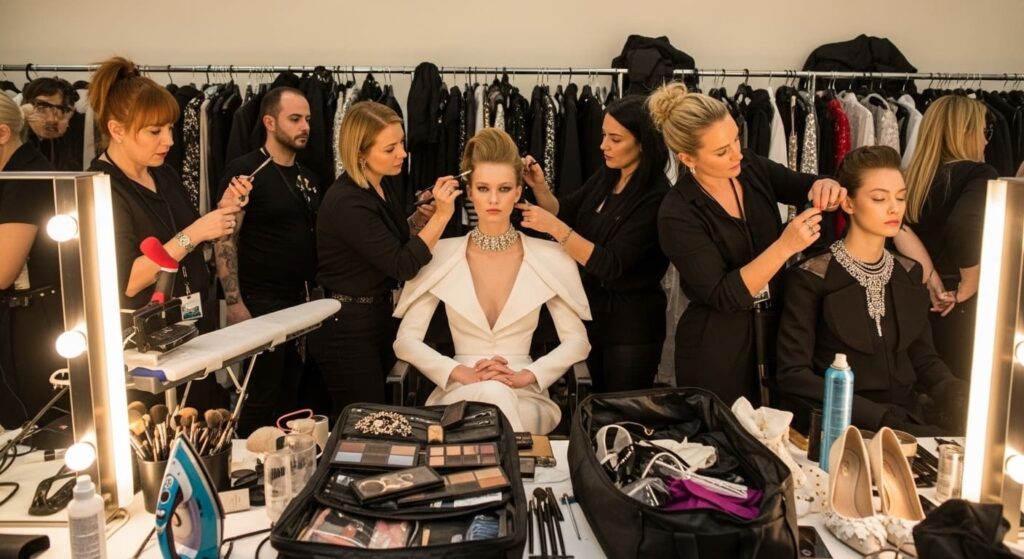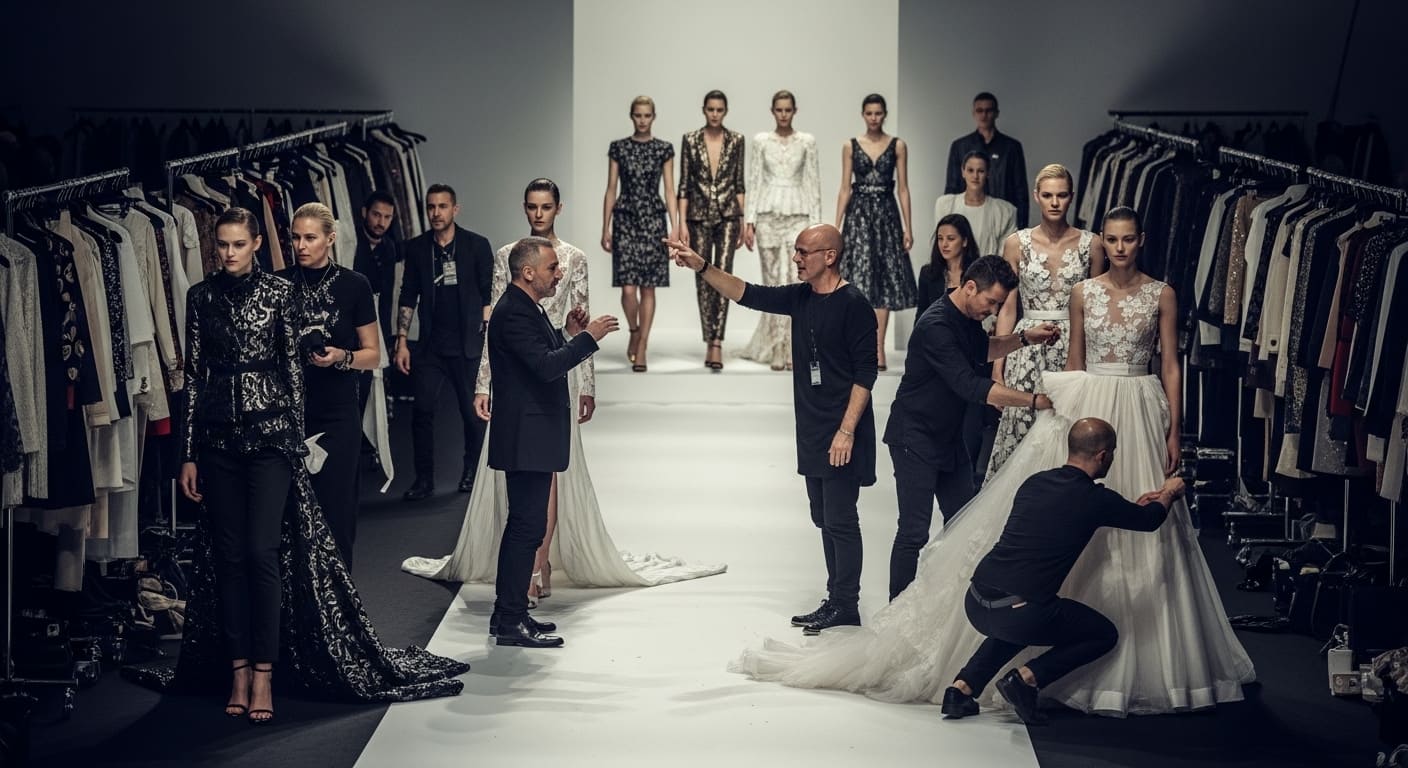Introduction:
Every year, fashion weeks take place in major cities such as New York, Paris, Milan and London. For viewers, it’s a dream – bright lights, flawless models and impressive design. But behind the ideal stage lies a completely different world. A world full of stress, back-to-back schedules, makeup mistakes, last-minute customization and creative anxiety.
Designers often work for months to create their collections. They make sketches, choose fabrics, monitor every detail and still make countless adjustments until the last minute. The night before the performance, many of them cannot even sleep. Models practice constantly, stylists work overtime, and production teams race against time to ensure every light, sound, and seat is perfectly aligned.
The result is a 15-minute show that seems effortless – but behind the effortless beauty lies weeks of exhaustion, coordination and adrenaline
Backstage: The real heartbeat of fashion week
If the runway is the stage, backstage is the heartbeat. This is where the real magic – and craziness – happens. The atmosphere heats up a few minutes before the show starts. You’ll find models standing in rows, designers nervous, stylists fixing hair, and makeup artists perfecting lips and eyelids at lightning speed.
It’s chaos backstage at Fashion Week. Teams communicate via short commands, photographers move in and out taking candid shots, and assistants sprint around with bags of clothes in hand. The air smells of hairspray, coffee and excitement.
Every second counts. Even a single delay can ruin the entire schedule. But amidst the noise there is unity – an unspoken rhythm shared by all who live for fashion.
The Models: More than just faces of the runway
The models who walk these runways are often portrayed as living symbols of perfection – but their journey is not an easy one. For them, fashion week is a marathon. They can walk for several designers in a single day, run from one place to another, sometimes change outfits and make-up in moving cars.
Blisters, fatigue and endless waiting are all part of their reality. They often have less than 10 minutes to change into their new look before returning to the spotlight. Yet his balance is never broken.
Behind the glamor is discipline—years of practice balancing grace and endurance, learning to transform stress into beauty.
The Designers: Dreamers under pressure
No one feels the pressure of fashion week like designers. His collections are not just clothes; They are the result of sleepless nights, creative risk-taking and emotional investment. Every stitch, color and silhouette represents their artistic identity – and a show can define or damage their reputation.
The designer often describes the week as both “fun and terrifying”. They deal with dress delays, fitting problems and media pressure together. A zipper breaks, a model cancels, or a sample is late – yet the show must go on.
Many describe the moment before their first model walks the runway as surreal – a mixture of fear and satisfaction. For them, fashion week is not just a show. It is their story told through clothing, texture and vision.
Stylist, makeup artist and invisible hero

While the models and designers grab the spotlight, it’s the stylists, makeup artists and hair teams who make this vision possible. They are the unsung heroes of fashion week, often working 14-hour days with little margin for error.
They create looks that complement both the designer’s concept and the model’s individuality. Sometimes he is asked to redo his entire look just minutes before the show starts. Makeup artists keep their kits ready for emergencies, and hairdressers fix everything from frizz to color mishaps under impossible deadlines.
Their teamwork is extraordinary – each person works as part of a creative machine that keeps the fashion world moving.
The Audience: Glamor meets influence
Front row seats at Fashion Week are more than just places to watch the runway—they’re status symbols. Celebrities, editors, influencers and buyers fill these spaces, creating a high-stakes environment where reputation, collaboration and networking matter as much as fashion.
For many influencers, being seen in a Fashion Week 2025 show is about more than presence – it’s strategy. A post from the front lines can increase their social media visibility overnight. Meanwhile, fashion editors and trend analysts inspect clothes, silhouettes and soundtracks to create runway reports that shape the global fashion landscape.
It’s a symbiotic relationship: Designers need exposure, and participants need content. Together, they make fashion week a global media phenomenon.
Sustainability and the new fashion week narrative
Over the years, fashion weeks have evolved beyond glamor to embrace responsibility. Sustainability is no longer a conversation behind the scenes – it is a central topic.
Designers are experimenting with eco-friendly fabrics, recycled materials and slow fashion principles. There are now different models on the runways promoting inclusivity and body positivity. The old standard of perfection is being replaced by authenticity and awareness.
Virtual fashion shows and digital presentations have also become commonplace, reducing the carbon footprint associated with large physical events. This shift marks a powerful new chapter – one that blends innovation with awareness.
The Emotional rollercoaster of Show Day
Exhibition day is the highlight of fashion week – a whirlwind of nerves and adrenaline. Hours before the show, models rehearse their walks, stage managers double-check lighting cues, and designers go over the final look one last time.
Then, as the lights dim and the music starts, everything goes quiet for a moment. All the turmoil, the late nights and the exhaustion merge into a single feeling – pride. The show begins, and in those few minutes, months of struggle seem worthwhile.
The viewer sees elegance; Backstage, tears are mixed with relief. After the closing ceremony, the team celebrates with laughter, hugs and sometimes sheer exhaustion. This is not just a fashion event – it is a joint triumph of art and perseverance.
Post-Show Reflections : The calm after the storm
When the applause dies down, the real work continues. Designers meet buyers, editors complete reviews, and models move on to the next show. The studios are full of leftover clothes, coffee cups and memories of a life-changing week.
For many, Fashion Week serves as a reminder of why they fell in love with the industry—not for the fame, but for the creative fire it ignites. Despite the stress, each designer, stylist and model walks away with new lessons learned and inspiration for what lies ahead.
The truth behind the glamour
When people think of Fashion Week, they imagine red carpets, couture gowns and champagne receptions. But the truth is rawer, more real. It’s about the people – artists, dreamers and creators who pour their hearts into a fleeting moment of beauty.
The glamor you see on the runway is only superficial. There are hundreds of hands and minds working together behind it – proving that fashion is not just an industry, but a form of storytelling driven by human emotion.
Conclusion:
Fashion Week is more than a spectacle – it is a world of contrasts. Glamor and exhaustion. Beauty and chaos. Art and business. What happens behind the scenes is a dance of passion, patience and precision.
The next time you see a perfectly staged runway, remember: Every sparkle on the catwalk hides a thousand stories of struggle, creativity and triumph. This is what makes Fashion Week not just an event, but a celebration of humanity wrapped in clothes and light.

